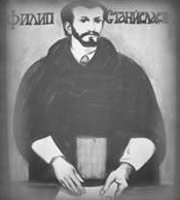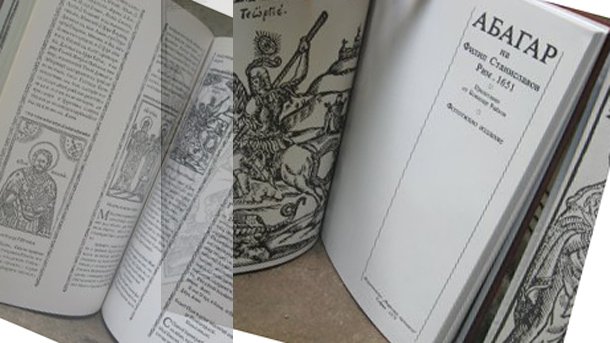
"Abagar" was the first printed book with elements of the modern Bulgarian language. It was printed in Rome on May 6, 1651 by the Bulgarian Catholic Bishop Philip Stanislavov. He was born around 1612 in an influential Paulician family in the village of Oresh near Svishtov. Paulicians were a heretical Christian religious movement preaching that the material world was a product of evil and the spiritual world was the realm of the good. It was among the Paulicians that the Roman Curia found fertile ground to spread the Catholic faith. With much persistence, the missionaries, mostly Franciscan monks, were able to attract them to the western church.

Perhaps his desire to see Bulgarians more educated made Philip Stanislavov prepare and print in Rome on May 6, 1651, a collection of prayers entitled "Abagar". The book was published in Cyrillic on one side of the page only - on five large sheets with a width of 44.5 cm and hight of 33.5 cm. The paper was Italian, thin but rough. In their bottom part, the sheets were numbered with Cyrillic letter digits. On each sheet the text is printed in four narrow columns, each of which is surrounded by a frame of ornaments, so if the columns are cut and lined up consistently, thus a line would be obtained about 5.80 meters long. Thus, the collection can be shaped like a scroll and worn as an amulet. The only preserved specimen of this type is located in the Bologna library.
This ability to carry the book as a mascot explains its name. It contains an apocryphal story about the message of the Ephesus King Abagar to Jesus, but the word abagar was also used to denote the special amulets that the Paulicians carried to protect themselves from evil forces. Indeed, the book is a collection of prayers whose language is close to that of the modern Bulgarian homilies that appeared in the same period. Its content was taken from the apocryphal and canonical literature.
The book is printed in the Bosnian Cyrillic script and according to many scholars its language is characterized by Church-Slavonic, Serbo-Croatian and new Bulgarian elements imported from the literary sources that Philip Stanislavov had available at the time. “Abagar” also has engravings which depict various saints and are characterized by the simplified and stylized form of Italian engraving.
In general, Abagar was a collection that was supposed to serve the needs of Catholic propaganda, but Bishop Stanislavov adapted it for Bulgarian society, for this reason it is written in a language understandable to ordinary Bulgarians. The book was an expression of his concern for the education and spiritual enlightenment of the Bulgarian people. The Bulgarian identity took prevalence inside him and he proved this in his subsequent life. The collection became popular among Bulgarians, and Philip Stanislavov continued his educational and missinary activities, traveling not only across his diocese but across many other places, as well.
As the author of the first printed book with elements of modern Bulgarian, Philip Stanislavov donated it to his people for the benefit of the Bulgarian nation. Being the bearer of high intellectual culture, he wanted to share it with ordinary Bulgarians. His activity was not restricted to the tenets of religion alone. It is educational, cultural, and patriotic. Today copies of Abagar are kept in the libraries of Rome, Vienna, Paris, Copenhagen, Brussels, Odessa, Moscow, Sofia and Leipzig.
Two centuries before the liberation of Bulgaria from five centuries of Ottoman rule, at the end of the book Stanislavov wrote: "Just as the bee is gathering wax and honey from different fragrant flowers, in the same way Philip Stanislavov, bishop of Greater Bulgaria, collected and compiled from various books of the Holy Fathers his own collected called Abagar and gave it to the Bulgarian people to use it as if it were powerful relics of a saint. This Abagar was printed in 1651 on 6 May in the Eternal City, where the bodies of Peter and Paul are buried."
English version Rossitsa Petcova